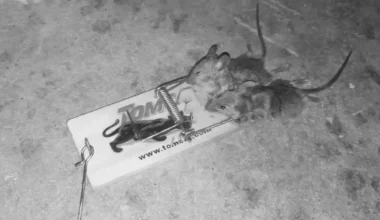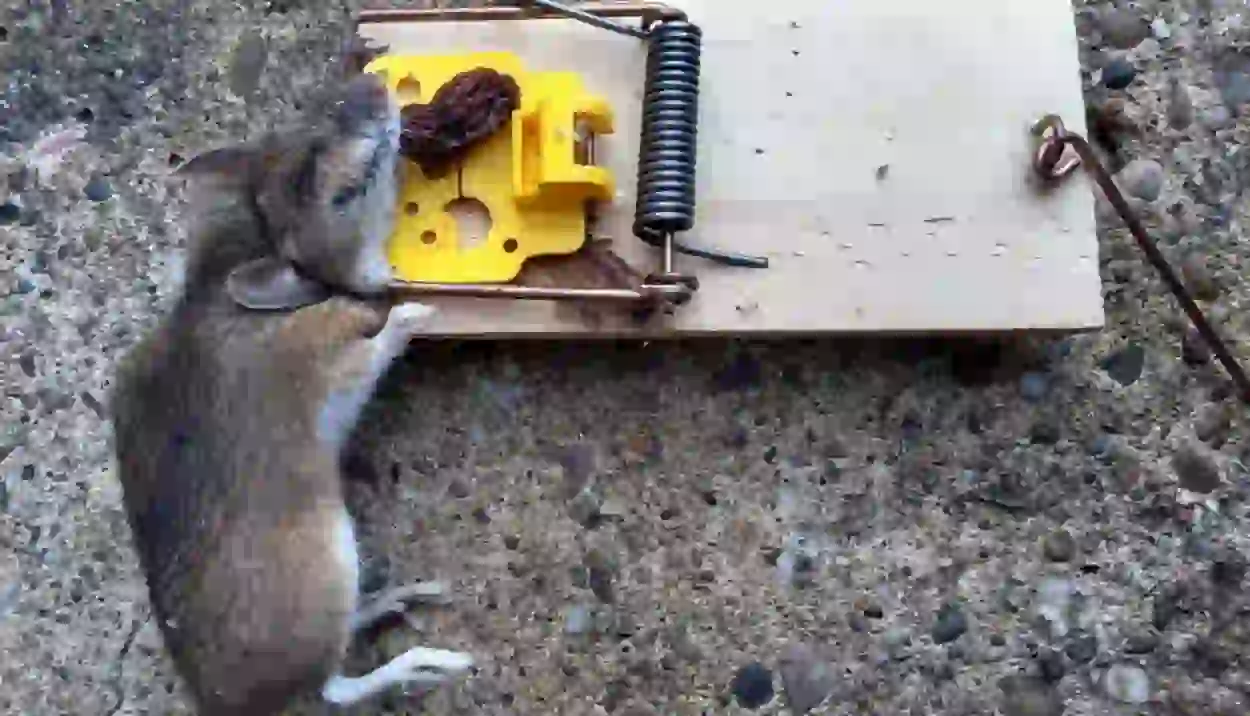Mice eating bait but not triggering trap? Now, the big question is: how do mice get bait without setting off trap? Mice can indeed steal the bait without triggering the trap but it could be your mistake that this is happening.
Meanwhile, although mice are not as aggressive, compared to rats, they can be a nuisance. Mice are also disease carriers, so you want them off your home once you see any signs of their presence. Usually, the first thing that comes to mind is “setting traps” but it happens that mice pick the baits without setting off the traps.
If the baits are going missing but no mice in the trap, this guide tells you what most pest control companies keep from you.
First of all, you want to be sure that you’re using the right kind of trap and that your bait is not excessive. In some cases, even your human scent can stick to the mousetrap, keeping mice away. If nothing works, get help from your local pest control professional.

Can mice eat bait without tripping trap?
Yes, mice can eat bait without tripping trap. This usually happens when you have overloaded the trap with bait, making it easier for the ferocious pest to steal some without going closer to the trap.
That said, a pea-sized amount of bait in a mouse trap is just enough. Suppose you use peanut butter in your trap and experience a mouse stealing peanut butter from trap, I have detailed the mistakes you should avoid to encourage mice into the trap.
Mice eating bait but not triggering trap
If mice are eating bait without tripping trap, below could be the possible reasons:
1. Excessive bait in the trap
Perhaps, you think that a large amount of bait in the trap will attract and catch mice but that’s not exactly true. Even though more food will attract the mice, the problem is that too much bait provides the pest enough room to eat some of the food to their satisfaction even before the trap is triggered.
You need a sizeable amount of bait, enough for mice to try taking everything. I recommend baiting with a pea-sized amount of food so that as the mice finish the feast faster, it increases the chance of them setting off the trap trigger.
2. Other pests could be stealing the baits
Your mice bait could be missing because other sneaky pests are stealing them. Your kind of trap may be unable to catch the stealing pest, probably because the trap is not designed for them. Some of the scavengers that could be stealing the baits without setting off the trap are:
- Insects. Cockroaches, ants, and slugs could be stealing your bait as they are capable of taking from traps without setting them off due to their smaller bodies.
- Rats. Here is another rodent whose larger and heavier body will help them get away with your mice baits without getting trapped. That’s to say that your mice-sized trap and bait are just not enough to catch the rat.
- Wildlife. If your mice trap is placed outdoors like in your attic, it is possible that animals such as squirrels are stealing the bait without triggering the trap.
Meanwhile, if you believe you have a rat infestation as well, you want a trap type capable of capturing rats or any other animal you’re dealing with.
3. Inappropriate bait
From childhood, you’ve been made to believe that cheese attracts mice the most, but this is not always the case. In fact, mice don’t like cheese as much as they like peanut butter, chocolate, and bacon—according to the Insider. Mice tend to prefer foods rich in carbohydrates. As such, if a mouse is not really interested in your food choice, it may eat only a little which won’t keep them long enough to trigger the trap to catch them.
Mice are attracted to nuts and seeds, so you want to bait them with peanut butter. However, peanut butter has a sticky inconsistency, so a mouse might be able to take it off the trap without setting off the trigger. If you decide to use solid food, make sure you can tie it to the trigger to force the mice to trigger the trap.
4. You placed the bait incorrectly
Your bait placement in the trap depends on the type of trap. So, if you place the bait incorrectly, it could make it easier for the mice to collect the bait and not trigger the trap. Let’s consider how you should bait your trap correctly depending on your mouse trap type:
- Pre-baited mouse traps. If you use a pre-baited mouse trap, no need to add any more bait as the scent of the trap is enough to lure a mouse or mice. Thus, adding baits may not lure mice close enough to set off the spring to capture them.
- Snap mouse traps. If using a snap mouse trap, place the bait on the rectangular metal bar to make it easy to set off once the mice pick the bait.
- Glue traps. You can use a lure like vanilla extract, chocolate, or peanut butter. Place the bait in the middle of the glue trap to attract the mice to it.
- Electronic mouse trap. Your mouse bait should be placed in the bait station at the back of the trap.
- Cube traps. If using a cube mouse trap, you should find a hook in the back of the trap for holding the bait. If you see holes in the trap around the box, place the bait a bit far from the edges to force mice to try to get in before they can reach the food.
- Bucket trap. A bucket trap works by capturing mice in a bucket. Secure your bait to the end of the plank so that when the mouse reaches it, the plank collapses easily for the mice to drop inside while the plank resets.
Generally, you have to place the baited end of your trap next to the wall so it forms a “T” with the wall (CDC’s recommendations). This is because mice prefer to run next to walls or other objects for safety and hate running in the open.
5. Wrong choice of trap
You want the right mouse trap available at your local hardware store or online. Be sure that the manufacturer has indicated that the said trap is specifically designed for mice.
If you invest in a rat trap, it may provide mice with just enough room to steal the baits without triggering the trap since rat traps tend to be larger due to the body size of rats. Some trap types to choose from for mice problem include:
- Pre-baited mouse traps. These are typical mechanical traps that are bait-scented on the trigger. So, you don’t need bait for this trap to catch mice.
- Electric mouse traps. As mice enter the trap and touch the metal plates, they get shocked and eliminated.
- Snap mouse traps. A snap mouse trap is the traditional mouse trap designed with a spring-release bar that snaps once a mouse touches the baited trigger.
- Glue traps. This type of mouse trap is a board designed with strong sticky adhesives that capture mice as they step on it. However, glue traps are considered inhumane.
- Cube traps. This trap type is designed in the form of a box with a passage that welcomes mice to baits but does not allow them to escape. Cube traps are considered humane as they keep the mice alive, giving you the option to release them elsewhere.
6. Low trap sensitivity
A common but typically neglected cause of missing baits without triggering trap is your mouse trap sensitivity settings. The Victor mouse trap, for example, has the firm and sensitive settings. In this case, you have to set the trigger to the most sensitive setting for a higher chance to catch the mouse stealing your bait. Refer to the specific product instructions to see if there are any options for modifying the sensitivity. This option is typically applicable if you use snap traps or traps with a similar feature.
If using a trap gives you problems, you could attempt to get rid of the mice with no trap at all.
How to catch a mouse that steals bait
Having known the possible reasons why your baits are missing but trap is not triggered, how do you catch the mice?
1. Acclimate the mice
First, you want the mice to become accustomed to your use of trap and feel safe getting closer to it. Experts recommend placing your trap with food without setting it for a few days. This is important not just to lure the mice but to get them to trust the trap. Mice are smart and are always wary of strange objects in their environment.
After you notice the mice getting comfortable with the unset trap, start setting it to get them caught as they try to collect the food as usual.
2. Place sizeable baits
Too many baits provide mice enough room to eat baits without springing the trap. Thus, you need fewer baits in the trap to attract the mice close enough to trigger the trap. Don’t worry about having too few baits; mice have a good sense of smell, so they will still be lured closer enough for the baited trap to capture them.
3. Mind your bait choice
Solid food such as cheese is easier for a mouse to break apart while eating from the trap without setting it off. Therefore, you need baits that you can tie to the string to easily catch the mice—they won’t be able to break the food without triggering the trap.
Note also that high-carb foods like seeds, nuts, and grains attract mice. Cheese is not part of the menu.
Consider spreading baits like peanut butter and hazelnut to attract mice to prevent mice from breaking off a piece for consumption which stops the trap from being triggered.
4. Bait with nesting materials
Consider using nesting materials such as string, dental floss, and cotton if food does not work.
Meanwhile, if you notice mice nests or nesting materials in your home, it’s a sign that you may have an infestation. In some cases, you may not be able to handle the infestation yourself without professional assistance.
5. Contact a pest control professional
Multiple mice in your home or workplace mean a possible large infestation and you risk property damage or health issues since mice carry diseases. Your DIY solution may not be enough to get rid of the infestation, so you need professional intervention from your local pest management service.
A reliable professional should have an established, working protocol that guarantees humane mice removal from your home, as well as methods that will prevent immediate re-infestations. Sometimes, you could just release a live mice back into the wild.






